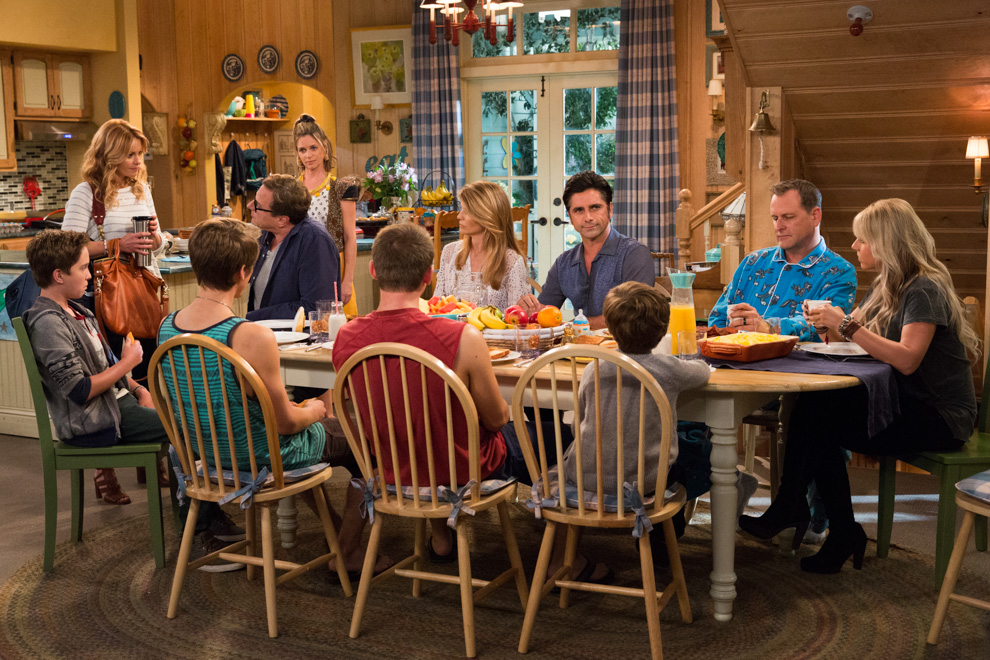The best part about “Fuller House” is its bold badness. The show nobody loved gets a reboot nobody wanted. In the Netflix Bakery, next to crisply-baked pastries like “Better Call Saul” and “Unbreakable Kimmy Schmidt,” a sad croissant like “Fuller House” seems stale from years of neglect. Most critics have found nothing worthwhile in this defibrillated product, acting genuinely surprised that “Full House” even had fans in the first place. (They do. I was one. I have no regrets.) What they fail to appreciate is the bat-guano craziness of the reboot. It’s hilariously self-aware of the original show’s cheesiness, raising it to such ludicrous heights that it comes out looking like some bizarre-o triumph of self-deflation.
The pilot opens like a David Lynch nightmare: a cold and abandoned room in long-shot, a baby sitting at a table alone, canned laughter wafting through the still air. The familiar faces of “Full House” have been grotesquely summoned from their 90s sitcom grave. Elvis-obsessed Uncle Jesse (John Stamos) remains his chipper old self, but Joey the creepy comic (Dave Coulier) and Danny Tanner the square dad (Bob Saget) have had the funny (and the fun) sucked from their faces. Like animatronic robots in search of meaning in their hollow lives, they zombie their way through each scene, absent-mindendly following the path to the nearest paycheck.
Their young daughters are much better actors and more committed to their roles. Recently-widowed D.J. (Candace Cameron Bure) and sister Stephanie (Jodie Sweetin) move back in to the Tanner residence to take care of D.J.’s three sons, as does annoying former neighbor Kimmy Gibbler (Andrea Barber). Gibbler is, in a cruelly ironic twist of fate, the best-developed character in this smorgasbord of after-school-special caricatures.
“Fuller House” is interesting because of the awkward intersection between its past and present. Its shoehorned references to iPhones, NorCal slang like “hella” and Donald Trump inspire sad, pitiable laughs. Trying to be hip with the fellow kids, it falls flat on its face.
The season itself has a palpable feeling of tiredness. Kitsch-phrases like “Have mercy!”, “How rude!” and “Cut. It. Out!” reappear with a vengeance. Like a stalwart Sting at one of his post-Police concerts, “Fuller House” rehashes the old hits it made popular years ago when they were much fresher. Why, for instance, did we have to be reminded of the time John Stamos butchered the Beach Boys’s perfect song “Forever”? The miracle of “Fuller House” isn’t that the old gang’s back. It’s that their house is still in the same museum-like condition after all these years. Barely escaping foreclosure after the housing bubble pop, it stands like the Winchester Mansion — a ghostly funhouse of horrors. The Tanner energy is gone. What we’re left with is the imperialist ruins of this milquetoast family who could make Norman Rockwell blush in embarrasment.
However, there’s something about the new “Fuller House” that’s very subtly anarchic. It works perfectly when it’s being self-depracating and ironic about its source material. Canned laughter, overcooked zingers, white-washed casts, a moral at the end of its story: “Fuller House” confidently continues the 90s formula for what made ratings-boosting family TV. It’s a time-capsule from a bygone era that doesn’t aspire to look back on its past with kind eyes. It sags and droops everywhere in its Lynchian tableaux, but couldn’t care less on how tightly wound it is.
In this respect, the closest cousin to “Fuller House” isn’t try-hard pastry-puffs like “Big Bang Theory” or bland white bread like “Valerie’s Family.” It’s surrealist masterpieces like Adult Swim’s “Too Many Cooks,” a seething satire on safe TV sitcoms that breaks apart halfway through and goes places you never expected. When a show like “Fuller House” comes along — an unabashed trip down Nostalgia Lane — it merits appreciation for embracing its trashy 90s past while reveling in its own liberating wackiness. “Fuller House” threatens to collapse into a Lynch film at any second. Of course, it never does, but the possibility always looms.
This new “Fuller House” also wishes to reflect the political correctness of today’s era with juicy aplomb. Remember Denise, Michelle’s black best friend who stuck out like an undeniable sore thumb and perpetuated a false illusion of racial harmony in the “Full House” universe? Now, in today’s more diverse times, she’s been quasi-updated as Ramona (Soni Nicole Bringas), the young Hispanic daughter of Kimmy Gibbler. Sweet, sweet, little Ramona is a Stephanie-like kid who, far from being the token minority sidekick, is actually given a leading role with substance. Here, the writers distinguish Ramona from her father, an insipid Latin-Lover-type named Fernando Hernandez-Guerrero-Fernandez-Guerrero. This hot-blooded idiot — a blight to all self-respecting Hispanics everywhere — is what came before. Ramona is what comes in the future and beyond.
“Fuller House” surprisingly well worth one’s time. You don’t need to watch every episode. (I only watched all the episodes that featured Stamos-Saget-Coulier and company in cameo appearances.) But it’s on its way to becoming a guilty-pleasure classic of cringe-y comedy. Netflix’s gambit proves that they’re committed to bringing the full experience of network TV to their innovative marketing model. And if that means green-lighting lightweight trash that only a couple people will really love, then so be it.
Contact Carlos Valladares at cvall96 ‘at’ stanford.edu.
